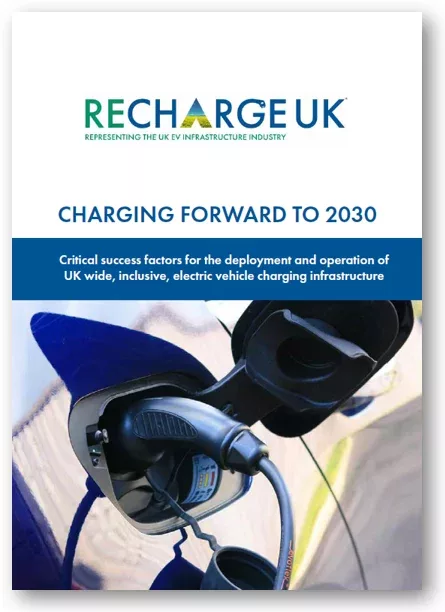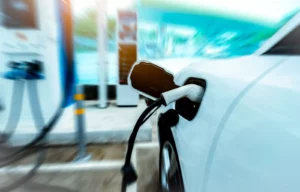A new report from electric vehicle trade group RECHARGE UK provides a roadmap of how the industry can accelerate chargepoint deployment to keep up with the growth of EV sales in the UK. RECHARGE UK is the EV arm of the REA (Association for Renewable Energy and Clean Technology) and was previously known as the REA EV Forum. The report was produced with the support of ChargeSafe, Field Dynamics, GreenFlux, Syzygy, Trojan Energy and Zap Map.
RECHARGE UK’s report ‘Charging forward to 2030: Critical success factors for the deployment and operation of UK-wide inclusive EV charging infrastructure’ sets out how to accelerate the rollout of EV charging by breaking down the policy and regulatory barriers to chargepoint deployment and meet the energy demand on the grid by 2030 from public charging.
There are currently over 40,000 public EV chargepoints in the UK, serving around 2% of vehicles on the road. In May 2023 EVs made up approximately 17% of new car sales but following the introduction of the Zero Emission Vehicle Mandate in 20241 they will make up as much as 80% of new car sales and 70% of new van sales by 2030, rising to 100% of both by 2035. This means there will be approximately 11 million EVs on the road by 2030, up from 760,000 today.
The report provides insight as to which parts of the UK are likely to experience high levels of public charging demand and will therefore require improvements to local energy networks and the deployment of flexible energy solutions.
Birmingham has the largest demand for energy in the UK of 339.9 GWh as it has the largest vehicle count of any part of the UK with 1.1 million vehicles today. Significant energy demand will therefore be put on Birmingham by 2030 and to future proof it, the report says that local authorities must begin examining where grid reinforcement is most likely to be needed over the next seven years. Glasgow is the second largest with 231GWh of demand, closely followed by Sheffield and Peterborough.
Furthermore, the report calls for EV infrastructure specific solutions to resolve geographic inequality in chargepoint deployment, ensuring that no areas are left behind on the electrification journey leading up to ban on the sale of new petrol and diesel cars and vans in 2030. The report recommends the following initiatives should be pursued to ensure chargepoint deployment can keep up with the growth in EV sales in the UK:
- Take action now to plan for public charging demand – Local strategies and action plans for EV charging need to be developed now. These can be informed from the data in this report highlighting where installing infrastructure can support the future charging demand, and where DNOs and National Grid will need to focus their efforts to ensure adequate electricity supply is available to support that infrastructure. Effective planning and central co-ordination will be critical to optimise deployment so that drivers looking to adopt an EV don’t feel put off by lack of charging availability.
- Implement the recommendations and guidance in this report to accelerate network deployment – This report highlights barriers to chargepoint deployment that if resolved could lead to a streamlined installation process that would lower costs and shorten timescales. If our recommendations are adopted, chargepoints will be installed quicker and therefore accessed by a far greater number of people to accelerate the transition to EVs delivering the highest levels of CO2 reduction, seeing the highest improvements in air quality.
- Support industry to address skills gaps – Although industry can set up bespoke training for their most needed skills, a more efficient, long-term strategy that could be adopted is for the Department for Education to link up with industry to identify potential courses that could be offered as part of a Green Jobs Campaign by Government. This would tap into the enthusiasm from young adults for green jobs and also include upskilling to ensure the existing workforce is not left behind in the electrification journey.
- Ensure there are multiple chargepoint types in safe and accessible locations – Apply intelligent design principles designed for optimum use by ensuring the multitude of different charging needs are met at charging locations. Multiple chargepoint types should be installed where possible. To gain and maintain public confidence in EV charging, chargepoints must be well-sited, in a safe location, usable by van drivers and other professional drivers which will all be equally important as EV ownership rises.
Matthew Adams, Transport Policy Manager at the REA (Association for Renewable Energy and Clean Technology) said: “Providing stakeholders across the EV landscape with a clear roadmap on how we can accelerate chargepoint deployment in time for the end of sale of new petrol and diesel vehicles in 2030 is vital.
“I am delighted we are able to highlight the clear need for more focus on areas outside of London and the South East in this report and how local authorities, Ofgem, Distribution Network Operators, Charge Point Operators, political parties and Government can contribute positively to chargepoint rollout and improve utilisation.
“Our key goal now is to promote these findings with stakeholders across Great Britain to engage with local authorities and devolved powers and discuss how they can overcome their unique barriers to chargepoint delivery and management.
“We see a significant opportunity from this for stakeholders to come together and talk on an equal footing on the best way to build charging infrastructure that is equitable and fit for the future.’’
Mark Constable, Chair of RECHARGE UK added: “This report focuses on a wide range of areas that have a vital influence over the whole UK’s ability to accelerate the rollout of electric vehicle charging infrastructure. The government has addressed several barriers already with financial incentives in many parts of the EV market. We hope they will go on to address some of the process challenges in both legislation and market operations – none of which was written with the transition to EVs in mind.
“There are no industry stakeholders who would not agree that these areas need reform. We hope that while change may not be implemented immediately, it will be met with near-universal support by consumers, user groups, industry associations, local authorities, network operators and those private companies with the investment necessary to fund the growth. Greater simplicity and greater clarity will lead to more consistency, which will accelerate the pipeline and show the industry can ensure the EV transition does not stall.
“The range of areas in the report – from smoother and less costly streetworks processes to the influx of skilled people across the value chain – demonstrates the ambition of RECHARGE UK in representing the interests of all EV infrastructure market participants and ensuring that innovation and improvement remains at the heart of the conversation. Consumers deserve nothing less.”
(Picture – RECHARGE UK)






















